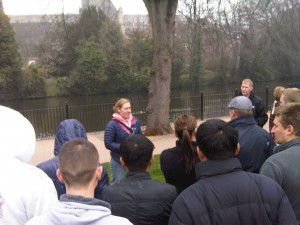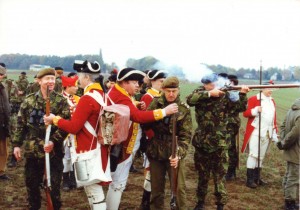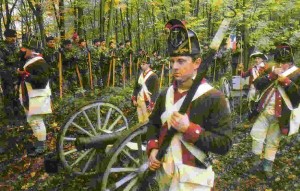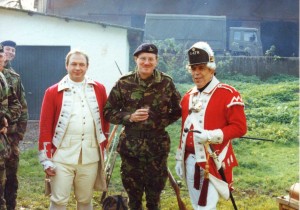
General Sir Richard Cyril Byrne Haking GBE, KCB, KCMG is best remembered, if at all, as the commander of XI Corps in the First World War, in particular for the high casualties suffered by his forces, including many Australian troops at the second Battle of Fromelles. However, he was a bit of an expert in using military history as the basis for officer training and wrote a book about planning staff rides and regimental tours. Lots of his ideas are still relevant.
Here is an extract from his book which says a lot about officer training.
“In modem war it is far more important than it has ever been in the past for junior officers to be highly trained. In the old days companies, battalions, brigades, and even divisions went into battle in close order side by side, or one behind the other. The General in chief command was able to conduct the operations even of the firing line, and orders could be conveyed rapidly to every part of the field.
Under modern conditions of war the Commander-in-Chief, by bold and skillful strategy, can bring his army into battle under favourable circumstances to himself and under unfavourable circumstances for the enemy, by skillful tactics he can prepare a blow against the enemy’s weakest point, but it is the company commander, assisted by the battery and squadron leaders, who must deliver that blow. It is these subordinate officers who to a great extent will win the battle, and it is of vital importance, therefore, that they should be highly trained, so that they will know at all times what to do, and will be prepared to do it without waiting for instructions.
It should be remembered that the battles of the Franco- German War were won mainly by the highly trained German captains. The strategy was good, but the subordinate Generals, though they showed great initiative and determination,did not display great tactical skill when bringing their troops into battle. The company commanders, however, by their bold and skilful leading, always pressing forward, always taking advantage of ground, and helping each other, assisted by the close co-operation of the artillery, were the chief cause of the German success. In Manchuria we learn the same lesson: the stubborn defence of the Russian captains, and the brilliant attacks of the Japanese company leaders, had quite as much effect on the campaign as the higher direction. It also appears that the battles were won by the successful attack of a comparatively small portion of the army that was engaged, and this fact accentuates the necessity for subordinate commanders to be men of great determination and highly trained in the art of war.”
 Staff Rides and Regimental Tours meant something different in the pre-First World War British Army to today. They were much closer to what would now be known as a Tactical Exercise Without Troops (TEWT). A situation would be taken complete from some campaign in history and transferred to a desired locality in England, India etc. For example, a staff ride held by the Chief of the General Staff from 3 to 7 September 1906 created a scenario based on problems encountered in operations that took place in the Po Valley in Northern Italy in 1703-04, 1706, 1799 and 1859. The military budget did not stretch to travelling to Italy, so they held it in Gloucestershire. Astaff Rides were seen as better than wargames because they used the ground rather than a map and cheaper and less constraining than field exercises. RUSI has some of the reports of these staff rides.
Staff Rides and Regimental Tours meant something different in the pre-First World War British Army to today. They were much closer to what would now be known as a Tactical Exercise Without Troops (TEWT). A situation would be taken complete from some campaign in history and transferred to a desired locality in England, India etc. For example, a staff ride held by the Chief of the General Staff from 3 to 7 September 1906 created a scenario based on problems encountered in operations that took place in the Po Valley in Northern Italy in 1703-04, 1706, 1799 and 1859. The military budget did not stretch to travelling to Italy, so they held it in Gloucestershire. Astaff Rides were seen as better than wargames because they used the ground rather than a map and cheaper and less constraining than field exercises. RUSI has some of the reports of these staff rides.
 Haking’s book included detailed instructions for planning and running Staff Rides, even offering practical advice for travel arrangements, and even specimen letters to send to hotels to negotiate food and accommodation for men, horses, cars and bicycles. Cars might be used by the directing staff, but bicycles were considered the most effective method of transport for participants. Though “senior officers should not be expected to ride bicycles.”
Haking’s book included detailed instructions for planning and running Staff Rides, even offering practical advice for travel arrangements, and even specimen letters to send to hotels to negotiate food and accommodation for men, horses, cars and bicycles. Cars might be used by the directing staff, but bicycles were considered the most effective method of transport for participants. Though “senior officers should not be expected to ride bicycles.”
There is a lot to be said for this approach to designing staff rides and battlefield studies as a straight forward way to link history events to modern tactical problems. The trick is to find the patch of ground and the history that has the most modern application.
The logic behind the use of historic settings was expressed in a remarkable quote.
We will take a simple tactical example, and we shall find that the formula we can construct whilst we are working out this problem will he useful to us in dealing with any other military situation, from a question whether it would be better to send forward a section or half a company to the future strategy involved in an attack by Mars against the Allied Powers of the Earth and Venus.
Not only is it a statement of the “eternal realities of war” but is the first mention in non fiction of the concept of interplanetary warfare.
If you want to read Haking’s “Staff Rides and Regimental Tours,” there is a copy in the staff ride services drop box.







































